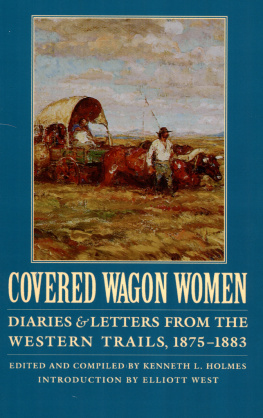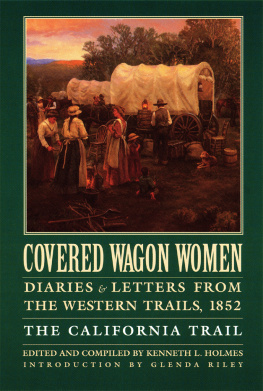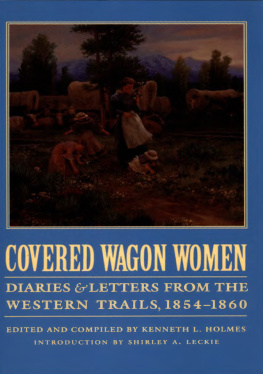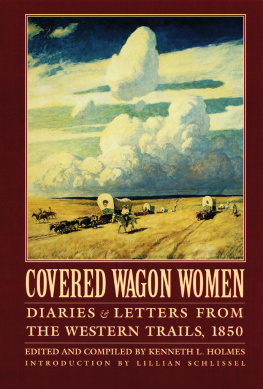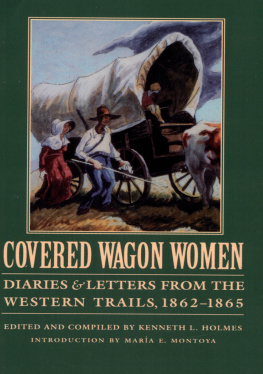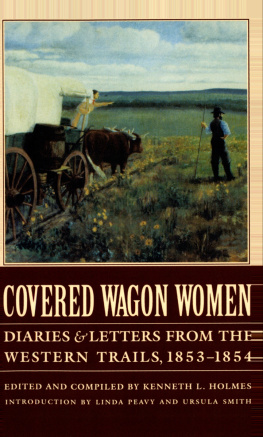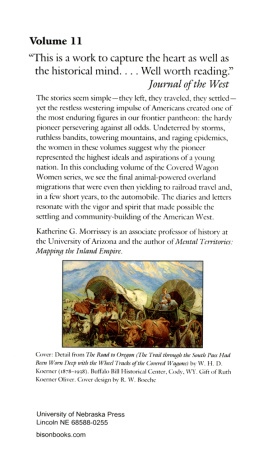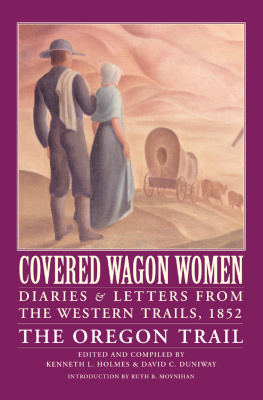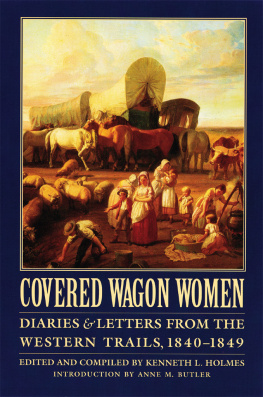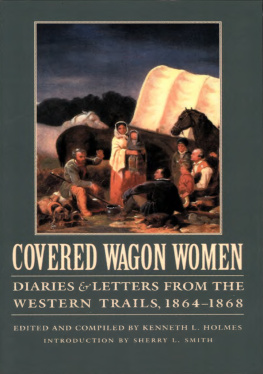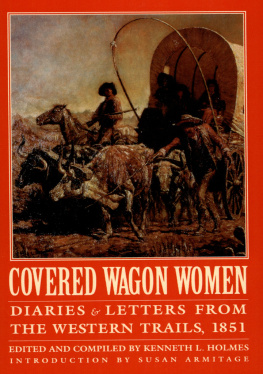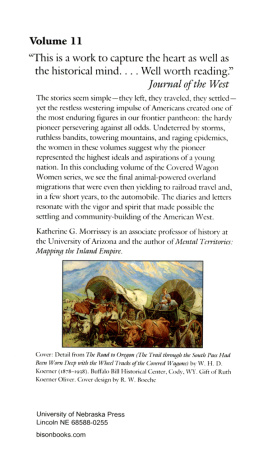Kenneth L. Holmes - Covered Wagon Women, Volume 10
Here you can read online Kenneth L. Holmes - Covered Wagon Women, Volume 10 full text of the book (entire story) in english for free. Download pdf and epub, get meaning, cover and reviews about this ebook. year: 2014, publisher: Bison Books, genre: Home and family. Description of the work, (preface) as well as reviews are available. Best literature library LitArk.com created for fans of good reading and offers a wide selection of genres:
Romance novel
Science fiction
Adventure
Detective
Science
History
Home and family
Prose
Art
Politics
Computer
Non-fiction
Religion
Business
Children
Humor
Choose a favorite category and find really read worthwhile books. Enjoy immersion in the world of imagination, feel the emotions of the characters or learn something new for yourself, make an fascinating discovery.
- Book:Covered Wagon Women, Volume 10
- Author:
- Publisher:Bison Books
- Genre:
- Year:2014
- Rating:3 / 5
- Favourites:Add to favourites
- Your mark:
- 60
- 1
- 2
- 3
- 4
- 5
Covered Wagon Women, Volume 10: summary, description and annotation
We offer to read an annotation, description, summary or preface (depends on what the author of the book "Covered Wagon Women, Volume 10" wrote himself). If you haven't found the necessary information about the book — write in the comments, we will try to find it.
Covered Wagon Women, Volume 10 — read online for free the complete book (whole text) full work
Below is the text of the book, divided by pages. System saving the place of the last page read, allows you to conveniently read the book "Covered Wagon Women, Volume 10" online for free, without having to search again every time where you left off. Put a bookmark, and you can go to the page where you finished reading at any time.
Font size:
Interval:
Bookmark:


1991 by Kenneth L. Holmes. Reprinted by arrangement with the Arthur H. Clark Company.
Introduction to the Bison Books Edition 2000 by the University of Nebraska Press All rights reserved
Library of Congress Cataloging-in-Publication Data
The Library of Congress has cataloged Vol. 1 as:
Covered wagon women: diaries & letters from the western trails, 1840-1849 / edited and compiled by Kenneth L. Holmes; introduction to the Bison Books edition by Anne M. Butler.
p. cm.
Originally published: Glendale, Calif: A. H. Clark Co., 1983.
Reprinted from volume one of the original eleven-volume edition
T.p. verso.
Volume 1.
Includes index.
ISBN 0-8032-7277-4 (pa: alk. paper)
ISBN -13: 978-0-8032-7479-2 (electronic: e-pub)
ISBN -13: 978-0-8032-7480-8 (electronic: mobi)
1. Women pioneersWest (U.S.)Biography. 2. West (U.S.)History. 3. West (U.S.)Biography. 4. Overland journeys to the Pacific. 5. Frontier and pioneer life West (U.S.) I. Holmes, Kenneth L.
F591.C79 1996 978dc20 95-21200 CIP
Volume 2 introduction by Lillian Schlissel
ISBN 0-8032-7274-X (pa: alk. paper)
Volume 3 introduction by Susan Armitage
ISBN 0-8032-7287-1 (pa: alk. paper)
Volume 4 introduction by Glenda Riley
ISBN 0-8032-7291-X (pa: alk. paper)
Volume 5 introduction by Ruth B. Moynihan
ISBN 0-8032-7294-4 (pa: alk. paper)
Volume 6 introduction by Linda Peavy and Ursula Smith
ISBN 0-8032-7295-2 (pa: alk. paper)
Volume 7 introduction by Shirley A. Leckie
ISBN 0-8032-7296-0 (pa: alk. paper)
Volume 8 introduction by Maria E. Montoya
ISBN 0-8032-7297-9 (pa: alk. paper)
Volume 9 introduction by Sherry L. Smith
ISBN 0-8032-7298-7 (pa: alk. paper)
Volume 10 introduction by Elliott West
ISBN 0-8032-7299-5 (pa: alk. paper)
The pagination has not been changed and no material has been omitted in this Bison Books edition.
The publisher does not have any control over and does not assume any responsibility for author or third-party websites or their content .
Introduction to the Bison Books Edition
Elliott West
You just never know what youll find in an overland diary. Mary Riddles, the second document in this volume, begins in early May of 1878, as her family leaves their farm near Coon Grove, Iowa. You read of the usual tearful good-byes, first frosty mornings in camp, and crossing of the Missouri River. Then on May 22: We drove through Grand Islandhere Dr. Cropper sold his monkeyit made them too much trouble in camp (26). We diary addicts mention this kind of journal moment to help explain our habit. After reading dozens of accounts, we feel like veterans of the trail ourselves. We know what landmarks to look for and what experiences lie ahead for the travelers. We learn to read their personalities during the first weeks; we make bets on how well they will hold up under the strain. The diary entries click off, metronomic and predictable in detail: Fort Kearny, Ash Hollow, Independence Rock, tired oxen, forage, cooking, sore throats, bison, antelope, and wolves. And then suddenly someone is selling a troublesome monkey.
Readers who have stayed with this splendid series of womens accounts of the westward journey, thankfully republished by the University of Nebraska Press, qualify for the club of the diary-addicted. You understand the peculiar grip of these documents. For newcomers, this tenth volume of Covered Wagon Women is as good a place as any to step vicariously into one of American historys most extraordinary experiences. Reading these accounts from 1875 to 1883, you can still get a vivid feel for those parts of the overland trekpart adventure, part grindunchanged since the first companies set off from the Missouri River valley for the Pacific coast in the early 1840s. By following these old roads, you can also watch the western country during one of its most rapid and wrenching transitions. Across it all is the distinct perspective of westering women, itself both persistent and changing, that gives all these volumes so much of their illuminative power. It is this combination of the daily drive of ordinary peoplea passage through an astonishing land, the marking of historical change, and the revelations of womens work and thoughtsthat draws new readers and keeps the rest of us coming back to these diaries and letters, volume after volume. That, plus the feeling that at any moment you might turn a page and hear about a monkey.
Among so much else, the documents in these ten volumes make for a marvelous study of continuity and change. Never in their history have Americans experienced more sweeping transformations than between 1845, the year of the trip Betsey Bayley describes at the start of the first volume of Covered Wagon Women , and 1875, when Angie Brigham Mitchell writes from the Arkansas River trail to open this tenth installment. Those three decades saw two wars, one foreign and one at home. The Mexican War (184648) along with the acquisitions of Texas (1845) and Oregon (1846) increased the nations size by a third, added resources almost beyond measure, and broadened the United States into a dual-oceanic empire. The Mexican War also made the United States the bully of the Western Hemisphere and deepened its own divisions between North and South, which led to the American Civil War. The Civil War was far and away the bloodiest in the nations history. Military occupation of the defeated Confederacy was ending in 1875, but the wars human and physical devastation was still much in evidence, as were the potentially revolutionary questions of citizenship and human rights emerging from the national trauma. With unquestioned dominance, the federal government was wrestling with the political and economic shape of what was, in effect, a new United States. It was also wallowing in some of the deepest and most blatant corruption that would ever be added to its frequently stained record.
Yet throughout the unparalleled changes of 184575, companies of wagons continued to snake their way across the continent. The movement had peaked during the westward flood of 184952, and it slowed during the cataclysm of rebellion and war, but the overland migration was nonetheless continual between the eve of the Mexican War and the end of Reconstruction (and remarkable for that, for continuity in anything was rare during this period). If nothing else the movement is a reminder that for many persons the shimmering possibility of a better life in the West blotted out differences of section and politics.
The original lure for overlandersthe legendary fertility of Oregons valleyspersisted. In the pages of this volume we see Mary Matilda Surfus drawn there from Kansas, Mary Riddle from Iowa, Laura Wright from Missouri. The years since 1845 had opened a slew of new opportunities. Reeling from several crop failures in Minnesota, Lucy and Allison Allen and their eight children set off in 1881 for Helena, Montana, as it drew on the gold and silver fields of the northern Rocky Mountains to become one of the Wests wealthiest cities. The twenty-one-year-old Angie Brigham Mitchell writes the opening letter on her way to Prescott, Arizona, where the silver mines must have seemed especially attractive in 1875, two years deep into one of the centurys worst depressions. Other families, including that of the future New York City mayor Fiorello LaGuardia, would follow the Mitchells to find a future in the desert mountains. Their journeys and those recorded in previous volumes serve as a catalogue of east-to-west longing. Their routes trace a succession of American dream-chasing.
Next pageFont size:
Interval:
Bookmark:
Similar books «Covered Wagon Women, Volume 10»
Look at similar books to Covered Wagon Women, Volume 10. We have selected literature similar in name and meaning in the hope of providing readers with more options to find new, interesting, not yet read works.
Discussion, reviews of the book Covered Wagon Women, Volume 10 and just readers' own opinions. Leave your comments, write what you think about the work, its meaning or the main characters. Specify what exactly you liked and what you didn't like, and why you think so.

